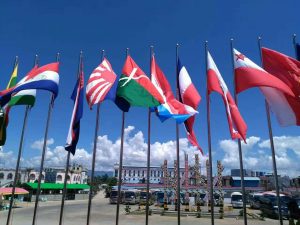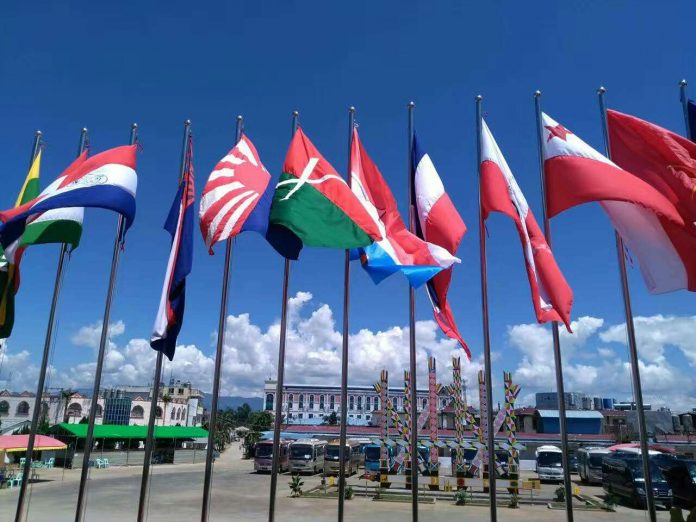A nation experienced with external and internal wars struggling for good governance, rule of law and basic living conditions for close to 80 years will celebrate its Independence Day on the 4th of January. After six decades of internal armed conflicts and political transitions, our country is seeking a new model of governance; at least we have found one simply from other countries. It is commonly referred to by the English word ‘federalism’ or a ‘federation state’ in modern political quotations. This political essay will be examining the current local administration of the Mon State Government and its rival opposition force, the New Mon State Party and the former military backed Union Solidarity and Development Party. The argument will also aim to shed light on its effectiveness, legitimacy and ideologies to best knowledge of this writer. A future federation of Myanmar will be explored based on the common interest of the entire population of the country but the conclusion will be left open to the reader’s own narrative.

The government of Mon State led by the MPs of the National League for Democracy is currently comprised of seven ministries or departments after the general election in 2015. The Chief Minister is directly appointed by the federal/union government according to the constitution amended in 2008. However, the ministers are then nominated by the Chief Minister for the approval of the federal/union Minister for Internal Affairs. According to reports by Mon News Agency (May, 2016), the Chief Minister presides over four departments, the Minister for Security and Border Affairs controls seven departments, the Minister for Energy and Technology oversees nine departments, the Minister for Social Affairs manages twenty-one units of administrations, the Minister for Agriculture, Communication and Transportation controls thirty units of Governmental Business, the Minister for Environmental manages five service units and the Minister for Finance, Resettlement and Human Resources presides over a total of eighteen service units. As the list displayed that the Mon State’s Ministers of Government technically provide basic services to the public but in fact, the overlapping of federal to state public services have confused the public.
On the contrary, the New Mon State Party, the Mon people’s first resistance armed political party has been running a parallel administration in rural Mon State for over six decades. The party was formed in 1958 after its mother party, the Mon People’s Front disarmed that same year. The party appointed a Chair and Secretary of District/Townships in five major Mon territories, namely, Pegu, Thaton, Moulmein, Tavoy and Myeik regions with an estimated thirty townships and hundreds of large villages. The local administers of the party manage issues such as land dispute, domestic violence, drug and rubber fields with little cash levy to the villagers or cash contributions received by the will of the villagers toward the party’s operational purpose. Mon villagers could access the party’s local committee either face to face or by messenger at local headquarters, but the most common location is in the jungle along the mountains in Mon territories.
From the late 1960s until the 2010s, local administration and public services were controlled by ex-military officials appointed by the generals. Local village chairmen were also appointed by the township administers by order. The local village chair was instructed weekly by the Township’s Head about the ongoing operational plans without check and balance for over six decades. The order shall not be ignored otherwise; the village’s chairperson will be punished financially or physically tortured. My father was appointed as head of militia and secretary of the village’s committee from 1980- 1988, but he fully resigned after the popular democratic uprising in 1988. Most local village committees were also punished by the New Mon State Party if they ignored the instruction of the local district chair by a warning instead of financial punishment or torture. The plight of local villagers and farmers was painful during the 1960s-1990s armed conflicts era because they had to obey two masters at once.
After six decades of military rule, our country is searching for a new model of governance, local administration and good public service for the entire country. The new democratic civilian government pledges on the auspicious event the 69th anniversary Independence Day, 2017, with the aim of building a genuine union in the future, making use of the common agreement which will emerge from the negotiations and discussions to be reached at the Union Peace Conference – 21st century Panglong; for all nationalities to collectively preserve and protect non-disintegration of the Union; non-disintegration of national unity; and perpetuation of sovereignty; to strive hard to draw up a constitution suitable for the union and in accordance with democratic principles and norms for the emergence of a democratic federal union; and to endeavor to create good economic conditions that ensure equitable development between the regions and the states that will conform with the national economic policy and goals.
A model of federal governance can be found in the sources of political literature either from the history of America, Canada or Australia. However, a model that the government of the Union of Myanmar can use will never be found in literature from the western world. It is simply too complex a subject. It can only be found through discussion, negotiation and compromise in a social, economy and political narrative. A proposal for self-determination of each local government shall be specific, timely, relevant and agreeable outcomes in terms of legal and practical manners. It is not a process of sharing the budget but it is rather a process of sharing the responsibility over two levels of governance.
If a Mon State government seeks for a better local governance and administration system in a new political discourse, the process is long but it is achievable through the shared goals in social, cultural, and political narrative regardless of race, gender and religion. The best work to be recalled in this essay is of a shared power and responsibility for the public. According to the dictionary of Australian politics, ‘federal is a form of government in which powers and responsibilities are divided between a central government and a number of provincial or state governments’. It clearly spells out that shared goals and responsibilities are the basic feature of federal governance.
A future federation of Myanmar will be achieved based on the common interest of the entire people of the country but the conclusion will be left open to the reader’s own narrative. My own argument is that an old ideology, ethnic-centered administration and racial political propaganda will only derail the framework of federal governance. However, most ethnic leaders have their own model of federalism without a clear framework or process of engagement with the public they are deemed to serve. Self-determination is a system of administration on the basis of the rule of law, equity and fairness to the entire public regardless of race, gender and religion but the system shall be just to the people in Mon territories.
Since Burma gained independence in 1947, the liberty of each citizen shall realize this aspiration coupled with pain and gain. A model of self-determination will only be functionally operated when the Mon State MPs and other political stakeholders, especially leaders from the New Mon State Party, outline a clear work plan and follow the action plan over the next 70 years and beyond.

